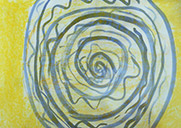Pen and Ink Illustration
HOOK: Create a dramatic pen and ink illustration that matches a scene from the novel, The Phantom Tollbooth written by Norton Jester and illustrated by Jules Feiffer.
SCHOOL: Blue Heron Middle School
TEACHING ARTIST:Susan Doyle
GRADE: 6 (can be adapted to any grade)
One 90 minute class
Lesson: Students learn about the evolution of the pen. Student then learn three pen and ink drawing techniques: Cross-hatching, Stippling, and generating a variety of lines to create drama and expression in their artwork.
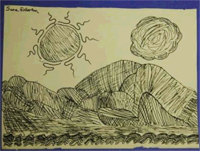
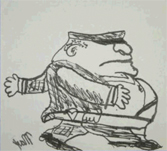
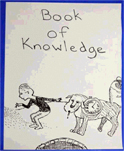
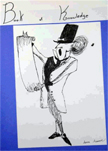
Student
Target Learning: Identifies four different types of pens from history.
Criteria: Names quill pen, reed pen, bamboo pen, and metal nib pen.
Target Learning: Experiments with three pen and ink techniques.
Criteria: Practices cross hatching, stippling, and generating a variety of lines (dashed, spiral, curly, jagged, curved, thick, and thin).
Target Learning: Selects a scene from the novel and illustrates it using pen and ink techniques.
Criteria: Creates one illustration showing character and/or setting from the Phantom Tollbooth and uses one or more pen and ink techniques in their finished artwork.
Target Learning: Creates value and expressive line with pen and ink techniques.
Criteria: Uses crosshatching or stippling to create shading and a line variety to emphasize dramatic story event in illustration.
Target Learning: Gains knowledge of use of art materials.
Criteria: Student handles pen and ink in an appropriate way as demonstrated by teacher.
Vocabulary (click here for the glossary)
Bamboo pen
Character
Crosshatching
Expressive Line
Fountain pen
Gesture
India ink
Nib
Quill pen
Reed pen
Setting
Stippling
Value
Variety of line: dashed, spiral, curly, jagged, curved, thick, and thin
Materials (click here to find sources)
Newsprint
India ink
Metal nibbed pens
White paper: 9x12 and 12 x18
Examples of quill feathers, bamboo sticks, fountain pens, ballpoint pens
Resources Introduced:
Examples of pen and ink illustrations with a variety of line types The Phantom Tollbooth by Norton Jester and illustrated by Jules Feiffer. The Steel Pen and the Modern Line of Beauty, by Seymour Howard; Technology and Culture Journal, The Johns Hopkins University Press
Creative process and resources introduced (lesson steps)
Teaching artist introduces lesson with discussion of evolution of the pen, from Prehistoric art to modern time. Sticks, sharpened stone, finger (prehistoric art), wooden and bone stylus, (Mesopotamia), bamboo and reed pens (Chinese and Egyptian), Quill (Western Civilization), metal nib (Industrial Age), fountain pens, ballpoint (modern) are discussed.
Teaching artist shares pen and ink illustrations by Jules Feiffer, then discusses various techniques. Appropriate tool use is emphasized: being conscious of India ink container staying upright, dipping only pen nib or tip in ink, not leaving pens in containers (easy to tip over), and holding pen at an angle with the smooth flat side up. All techniques are demonstrated.
Students practice cross hatching, stippling, and making a variety of line types. Concept of creating value and expressive gesture or dramatic action using line is discussed in context of illustrations. Density of crosshatching and stippling to show areas of light and dark value is demonstrated.
Students select one scene featuring characters and/or setting from The Phantom Tollbooth and complete one final drawing to go on the cover of their "Book of Knowledge". Students are encouraged to communicate dramatic story content in their illustration by using a variety of line intentionally and expressively.
Assessment (strategies, forms, guidelines, reflection questions)
Student self assessment/reflection writing sheet (included)
Class critique
Teacher observation and guidance during studio practice (embedded assessment)
Teaching artist & teacher evaluation of student work and narrative reflection
Essential Learnings (Art and other EALR's referenced)
1.1.1 Concepts and Vocabulary: Line, pen and ink vocabulary
1.2 Arts skills and techniques: Pen and ink drawing/illustration
1.3 Understands various cultures and times: History of the pen in different cultures
2.1 Applies Creative Process: Creates pen and ink illustration for Book of Knowledge to present to others/parents
3.1 Expresses and presents ideas and feelings: Uses line to show value and expressive qualities in artwork
3.2 Uses artwork for a specific purpose: Art work goes in student Book of Knowledge. Student knows how to use line to develop tone and drama in art work.
4.2: Makes connections among arts and other disciplines: Literature, History: Development of steel nib during industrial age – use of quill pen obsolete-Discussion
4.4 Arts shape and reflect culture and history. Development of the pen refines style in calligraphy and illustrations.
